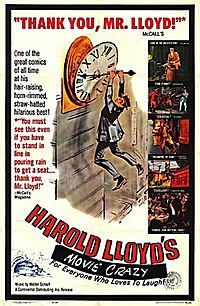Lloyd kept copyright control of most of his films and re-released them infrequently after his retirement. Lloyd did not grant cinematic release because most theaters could not accommodate an organist, and Lloyd did not wish his work to be accompanied by a pianist: "I just don't like pictures played with pianos. We never intended them to be played with pianos". Similarly, his features were never shown on television as Lloyd's price was high: "I want $300,000 per picture for two showings. That's a high price, but if I don't get it, I'm not going to show it. They've come close to it, but they haven't come all the way up". As a consequence, his reputation and public recognition suffered in comparison with Chaplin and Keaton, whose work has generally been more available. Lloyd's film character was so intimately associated with the 1920s era that attempts at revivals in 1940s and 1950s were poorly received, when audiences viewed the 1920s (and silent film in particular) as old-fashioned.
In the early 1960s, Lloyd produced two compilation films, featuring scenes from his old comedies, Harold Lloyd's World of Comedy and The Funny Side of Life. The first film was premiered at the 1962 Cannes Film Festival, where Lloyd was fêted as a major rediscovery. The renewed interest in Lloyd helped restore his status among film historians. Throughout his later years he screened his films for audiences at special charity and educational events, to great acclaim, and found a particularly receptive audience among college audiences: "Their whole response was tremendous because they didn't miss a gag; anything that was even a little subtle, they got it right away".
Following his death, and after extensive negotiations, most of his feature films were leased to Time-Life Films in 1974. As Tom Dardis confirms: "Time-Life prepared horrendously edited musical-sound-track versions of the silent films, which are intended to be shown on TV at sound speed [24 frames per second], and which represent everything that Harold feared would happen to his best films".
An acclaimed 1990 documentary, Harold Lloyd: The Third Genius by Brownlow and Gill, which was shown as part of the PBS series American Masters, created a renewed interest in Lloyd's work but the films were largely unavailable. In 2002, the Harold Lloyd Trust re-launched Harold Lloyd with the publication of the book Harold Lloyd: Master Comedian by Jeffrey Vance and Suzanne Lloyd[27][28] and a series of feature films and short subjects called “The Harold Lloyd Classic Comedies” produced by Jeffrey Vance and executive produced by Suzanne Lloyd for Harold Lloyd Entertainment. The new cable television and home video versions of Lloyd's great silent features and many shorts were remastered with new orchestral scores by Robert Israel. These versions are frequently shown on the Turner Classic Movies (TCM) cable channel. A DVD collection of these restored or remastered versions of his feature films and important short subjects was released by New Line Cinema in partnership with the Harold Lloyd Trust in 2005, along with theatrical screenings in the US, Canada, and Europe. Criterion Collection has subsequently acquired the home video rights to the Lloyd library, and have released Safety Last![29] and The Freshman.[30]
In the June 2006 Los Angeles Chamber Orchestra Silent Film Gala program book for Safety Last!, film historian Jeffrey Vance stated that Robert A. Golden, Lloyd's assistant director, routinely doubled for Harold Lloyd between 1921 and 1927. According to Vance, Golden doubled Lloyd in the bit with Harold shimmy shaking off the building's ledge after a mouse crawls up his trousers.[31]

No comments:
Post a Comment